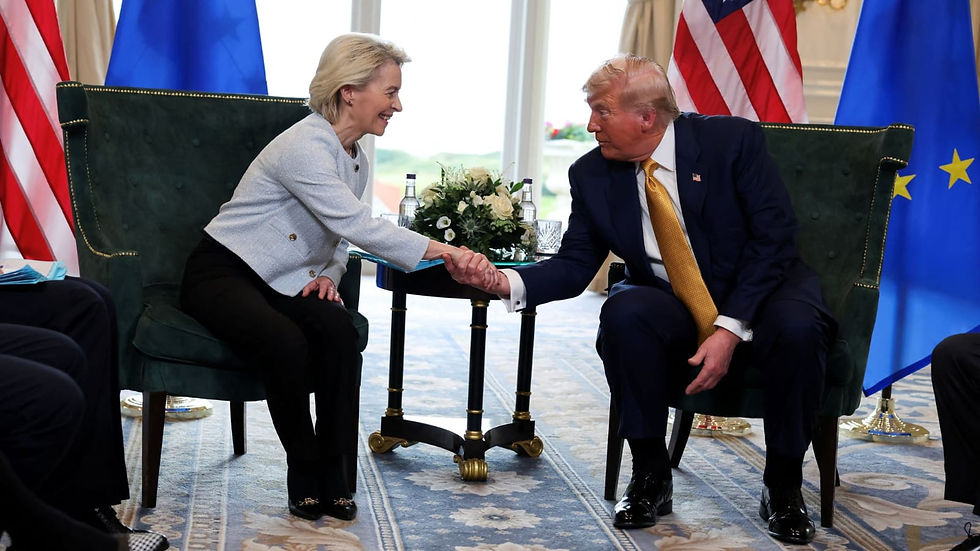Understanding the Impact of the Recent EU-US Trade Agreement
- Cemre Sanlav
- Aug 10
- 4 min read
Updated: Aug 11
In late July 2025, the European Commission and U.S. President Donald Trump announced a landmark trade framework. Under the deal, the United States will impose a 15% tariff on most EU exports, down from the 30% Trump had threatened but far above the pre-Trump rate, which was 4.8%. In exchange the EU will scrap many of its own industrial tariffs on U.S. goods (including cars and some technology) and liberalize agricultural imports. The agreement also includes large reciprocal commitments: the EU has pledged to buy roughly $750 billion of American energy and to invest about $600 billion in the U.S. economy over the next few years.

The package was billed as averting a full-blown transatlantic trade war. As Reuters reported, the deal “imposes a 15% import tariff on most EU goods, half the threatened rate, and averts a bigger trade war” between the world’s two largest economies. In the words of President Trump, this was “the biggest deal ever made,” while Commission President Ursula von der Leyen said 15% was “the best we could get.” However, European leaders immediately voiced deep misgivings. Hungarian Prime Minister Viktor Orbán famously complained that “Donald Trump ate von der Leyen for breakfast,” calling the EU negotiator a “featherweight” to his “heavyweight.” France’s centrist prime minister François Bayrou decried the outcome as “a sombre day when an alliance of free peoples…resigns itself to submission.” Even Germany’s Chancellor Friedrich Merz, though supportive overall, warned that a no-deal situation “would have hit [Germany’s] export-oriented economy and its large auto sector hard.”
Many other EU figures struck a middle note. Spanish PM Pedro Sánchez said he valued the Commission’s efforts and would support the deal “without any enthusiasm.” Ireland’s trade minister, Simon Harris, welcomed the certainty for businesses, though he “regrets that the baseline tariff of 15% is included.” Swedish Trade Minister Benjamin Dousa judged the accord “not mak[ing] anyone richer, but it may be the least bad alternative.” In short, a chorus of leaders acknowledged that 15% is painful but far preferable to the 30–50% levies Trump might have imposed. As one EU official noted, the 15% rate “has caught the EU precisely at its pain threshold,” roughly the highest duty rate Europe can.
Economists and trade experts largely agree that the agreement is asymmetric but avoids a worse outcome. The pattern of reciprocal tariffs, matching U.S. duties to those EU charges on Americans, was a novel Trump policy. By accepting 15% on its exports, the EU maintains at least parity with other U.S. partners, as Japan agreed to similar terms. Importantly, even a 15% tariff does not zero out trade: European companies expect to continue exporting, and U.S. importers will have to decide how much of the cost to. Analyses suggest the macroeconomic pain will be modest as a hit to EU GDP of only about 0.3–0.5% is expected, while the U.S. economy might shrink by roughly 1% of GDP and suffer higher. In other words, the bulk of the tariff burden may ultimately fall on American companies and consumers (through higher prices) rather than entirely on EU exporters. As J.P. Morgan analysts noted, tariffs “may at first squeeze the margins of some EU exporters… but could eventually fall on U.S. importers and customers.”
A key reason Brussels agreed to these terms was geopolitics. EU officials stressed that the deal was “not only about trade… it is about security; it is about Ukraine.” With much of European defense reliant on U.S. support and a fragile situation in Ukraine, EU leaders feared that a trade war could endanger broader cooperation. Trade Commissioner Maroš Šefčovič explicitly said the negotiations were about keeping “the transatlantic alliance.” Commissioner von der Leyen similarly framed the agreement as a “second building block for reaffirming the transatlantic partnership” just weeks after NATO’s. In effect, EU capitals decided that placating President Trump on trade might secure his ongoing commitment to NATO funding and aid for Ukraine. The compromise drew on lessons from other trade disputes: Dan Mullaney, a former U.S. trade negotiator, argued that the EU “couldn’t have hoped for a better outcome” given the risks of escalation. He doubted that a harder line would have succeeded, noting that countries, including the EU itself, had ended up worse off after prolonged tariff battles.
In exchange for external market access, European critics argue, the EU has highlighted its own weaknesses. The IMF has estimated that internal EU trade frictions are equivalent to a 44% tariff on goods. By comparison, Trump’s 15% duty is relatively small. The new Commission is now vowing to tackle these “terrible” barriers to growth: proposals in May targeted fragmented rules on professional services, standards, and packaging, with a view to letting companies sell seamlessly across Europe. As former ECB head Mario Draghi wrote in 2024, Europe’s real problem is its own lack of reform and investment. Many economists echo that: even if the deal leaves the EU paying slightly higher prices, the real drag on Europe’s competitiveness is homegrown.
The EU–US tariff deal remains controversial. Skeptics brand it a lopsided capitulation to Trump. Proponents counter that it held the line against worse tariffs while keeping the transatlantic alliance intact. With execution still unfolding, the deal’s full impact will emerge over months. For now, as the Swedish trade minister noted, the deal “may be the least bad alternative.” It spares the EU an immediate crisis and buys time but also underlines that Europe’s economy must become more dynamic and unified if it is to negotiate from a position of strength.


